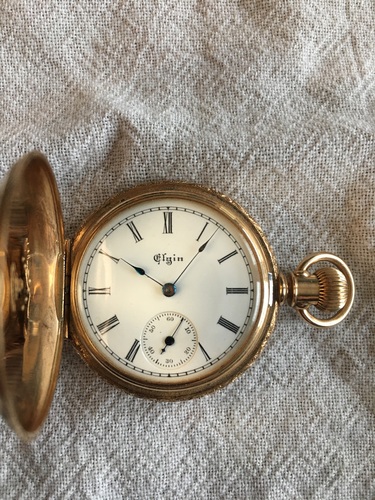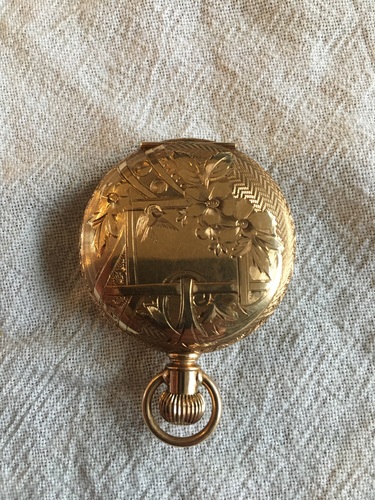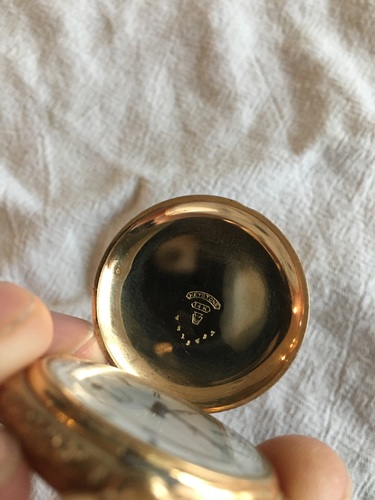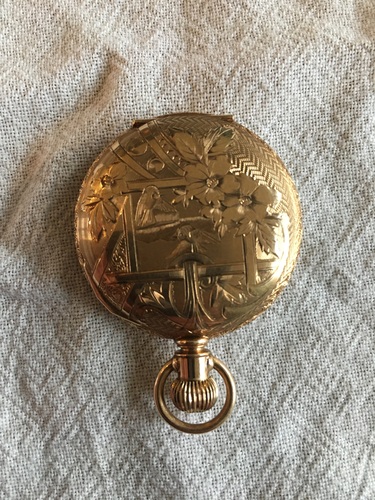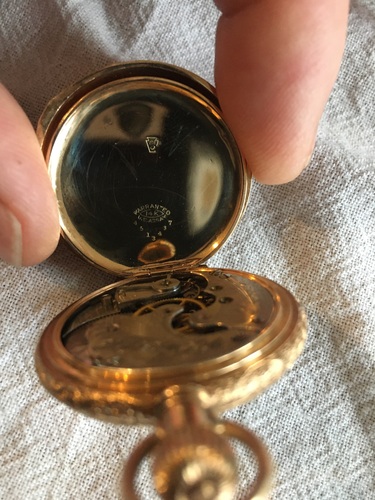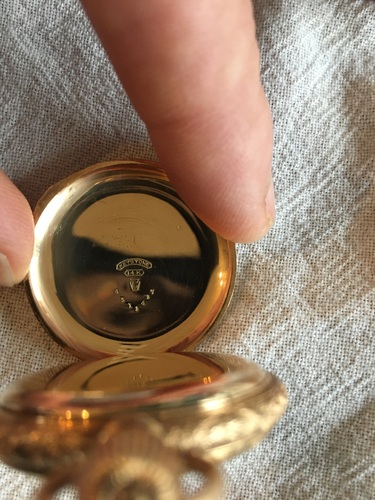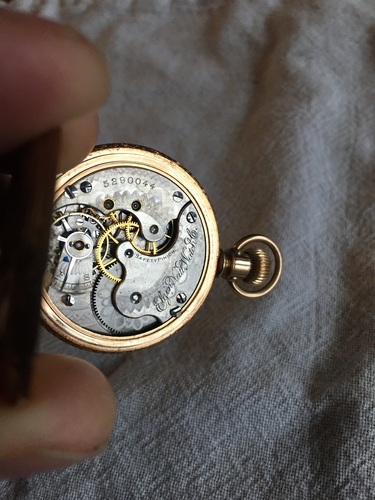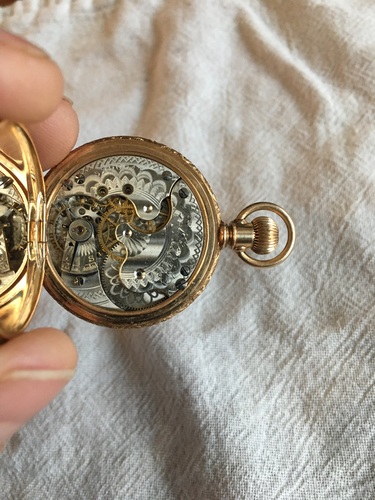14K Gold Woman’s Pocket Watch. Elgin watch. Keystone cover. Approximately 1 3/8” in diameter. Approximately 36 grams. Circa, 1894 (according to serial number on movement).
Handed down from great grandfather who owned a jewelry store (Bosshart & Morphy) in Clifton Springs, NY from early 1900’s until the mid-1950’s.


Hello Robert,
Thank you for sending in this family heirloom pocket watch to mearto.com for an appraisal. I shall try to help you with that today
TITLE:
Ladies, art Nouveau, 0-size (Jewel size), 14K yellow gold, pendant wound and pendant set, savonette, hunting case pocket/pendant watch, Grade 115, mad by the Elgin National Watch Company,
Elgin, Illinois, circa 1894.
PROVENANCE:
“Handed down from great grandfather who owned a jewelry store (Bosshart & Morphy) in Clifton Springs, NY from early 1900’s until the mid-1950’s.
DESCRIPTION:
Case: Size-0, keyless, four leaf, 14k gold, ladies hunting case pocket/pendant watch with a gold fluted ball pendant and round bow placed at the three position (savonette) relative to the dial and opposite the case hinge. Both outer covers are engraved with floral, foliate and avian forms within a trellis structure, all very much in the natural style of the Art Nouveau era of circa 1880-1910.
The inside of the covers has the case number 4513437 and indicates the case was made by the Keystone Watch Case Company (see History), while the USA Assay has warranted the quality of the 14k gold.
Dial: Round white enameled dial with Roman hours, closed minute track, sunken subsidiary seconds dial @6, steel American style Spade hands and the upper dial signed in “Olde English” ‘Elgin’.
Movement: This is a 0-size, damascened nickel, split three-quarter plate movement, the grade 115, model 1, class 59 movement made by the Elgin National Watch Company of Elgin, Illinois. The movement has the serial number 5290044 indicating production in 1894, in a run of 1000 such units, each made with 13 jewels, made for placement in hunting cases, going barrel, quick train, bimetallic balance wheel for temperature compensation, no other adjustments and not of railroad grade with a plain index regulator marked with initials for faster and slower.
CONDITION:
Case – Excellent with almost total absence of any blemish whatsoever.
Dial – Superb, clean and no hairlines present.
Movement – excellent, original to this case, genuine and functional.
Does not get much better than this for any pocket watch.
HISTORY of the KEYSTONE WATCH CASE COMPANY:
In 1853 Randolf & Reese Peters were making watch cases in Philadelphia, employing James Boss in their movement department. In 1859 - J. Boss received a patent for "spinning up" cases made of "gold-filled" type material. That is, material made of a sheet of composition metal (usually brass) sandwiched between two thin sheets of gold. Boss formed cases by rolling sheet metal as opposed to the traditional method involving soldering and cutting. Rolling increased the molecule density of the metal. His patent, No. 23,820 of May 3, 1859, revolutionized the watch case industry by enabling the production of not only less expensive, but considerably stronger cases. ... Unlike gold washed cases, which were made using electroplating, cases produced by means of rolling had much harder gold surfaces and were thus less apt to wear. In 1871 Boss sold patent rights to John Stuckert of Philadelphia. By 1875 - T.B. Hagstoz & Charles N. Thorpe at 618 Chestnut St. Philadelphia purchased the "J. Boss" patent from the estate of John Stuckert. Hagstoz & Thorpe seems to have made only gold-filled cases using the J. Boss patented method. Orders increased so rapidly that larger quarters became necessary immediately. A new plant on Brown Street was erected. In 1877 the E. Tracy case company, a manufacturer of solid gold and silver watch cases, was acquired. n 1880 - the company moved to a six-story building on Nineteenth St., with an equal-size annex on Wylie St. Between 1883 - 1885 - T.B Hagstoz withdrew from the company which became C.N. Thorpe Co. and shortly thereafter it was reorganized as the KEYSTONE WATCH CASE COMPANY. The firm was producing 1,500 cases per day by 1889. By merging with and purchasing other watch case and watch making companies Keystone, by 1911 was the largest watch case company in America.
ELGIN:
The Elgin National Watch Company was founded in 1864 in Elgin, Illinois as the National Watch Company. In 1874 the name was changed to the Elgin National Watch Company. Between 1864 and sometime in the 1960s, Elgin manufactured tens of millions of pocket and wrist watches. The Elgin National Watch Company was for a time, one of the largest industrial concerns in the world. Elgin pocket watches from the early years are particularly interesting because of the methods and philosophy of the Elgin company. Elgin used what were at the time quite advanced tools, techniques and labor practices to achieve a very high-quality product, in high volumes, at a relatively affordable price. Elgin watches were created using mechanized, repeatable processes, organized quality control and standardized, interchangeable, parts. These things are all common practices in industry today, but not so at that time. The result was a product of high quality made in large quantities that dwarfed that of Elgin's competitors. Prior to Elgin's time, watches were made completely by hand, frequently by a single craftsman, from start to finish. Repairs could only be completed on such watches by someone with sufficient skill to fabricate replacement parts, from scratch, from raw material. Elgin watches on the other hand, were mass manufactured and highly standardized. Spare parts high-quality were provided by Elgin that were drop-in replacements for the originals. Elgin was extremely successful with this strategy. In fact, the company introduced more than half the watches made in America from 1920-1928. An Elgin advertisement in 1928 claimed that there were more than 14,418 retail jewelers in the United States and all but 12 carried Elgin
PRICING:
In view of the condition of this particular example I am going to skip looking for comparables to compare it with and be guided in pricing by the online “pocket watch database” which puts the fair market value of your watch, given its superb condition, in the fair market range of $585-$615, with retail values approaching twice that amount. This is truly a wonderful little family heirloom piece. I hope you find pleasure in reading all about this fine pocket watch. I enjoyed doing the appraisal for you.
Thank you for choosing mearto.com.
My best,
David
{{p.s. if sold on the gold market, which would destroy the watch, the value to you would be roughly $472.
36 grams=1.26986 ounces x 40% (60% of a hunting case watch is the dial and movement weight) = 0.50795 ounces of 14k gold metal x 0.585 (14k gold is 14/24ths pure gold or 0.585) = 0.29613 ounces of
Pure 24k gold x $1876/ounce = $556 less a 15% retailer fee leaves you $472.}}
Please log in to your Mearto account to contact this seller or make an offer on this item.
